
Chives, scientific name Allium schoenoprasum, is a species of flowering plant in the family Amaryllidaceae that produces edible leaves and flowers. Their close relatives include the common onions, garlic, shallot, leek, scallion, and Chinese onion.

Allium tricoccum is a bulbous perennial flowering plant in the amaryllis family Amaryllidaceae. It is a North American species of wild onion or garlic widespread across eastern Canada and the eastern United States. Many of the common English names for this plant are also used for other Allium species, particularly the similar Allium ursinum, which is native to Europe and Asia. An edible plant, Allium tricoccum is used in a variety of North American and indigenous cuisines, and has also been used by Native Americans in traditional medicine. A French rendering (chicagou) of a Native American name for this plant is the namesake of the American city of Chicago.
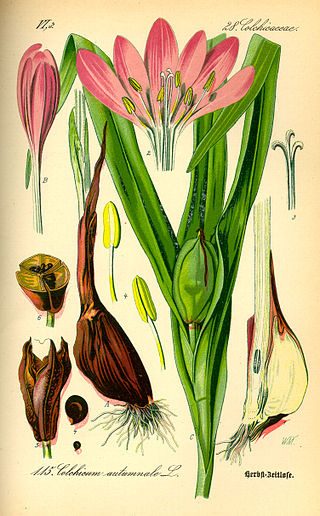
Colchicum autumnale, commonly known as autumn crocus, meadow saffron, naked boys or naked ladies, is a toxic autumn-blooming flowering plant that resembles the true crocuses, but is a member of the plant family Colchicaceae, unlike the true crocuses, which belong to the family Iridaceae. It is called "naked boys/ladies" because the flowers emerge from the ground long before the leaves appear. Despite the vernacular name of "meadow saffron", this plant is not the source of saffron, which is obtained from the saffron crocus, Crocus sativus – and that plant, too, is sometimes called "autumn crocus".

Allium vineale is a perennial, bulb-forming species of wild onion, native to Europe, northwestern Africa and the Middle East. The species was introduced in Australia and North America, where it has become a noxious weed.
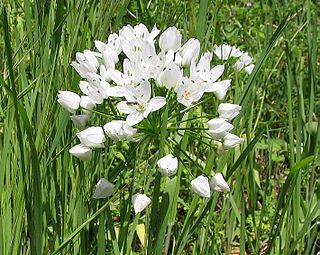
Allium neapolitanum is a bulbous herbaceous perennial plant in the onion subfamily within the Amaryllis family. Common names include Neapolitan garlic, Naples garlic, daffodil garlic, false garlic, flowering onion, Naples onion, Guernsey star-of-Bethlehem, star, white garlic, and wood garlic.

Allium nigrum, common name black garlic, broad-leaved leek, or broadleaf garlic, is a Middle Eastern species of wild onion. It lacks the onion or garlic scent shared by most of the other species in the group. The species is native to Turkey, Cyprus, Syria, Lebanon, and Israel but cultivated as an ornamental in many other places. It has become naturalized in some regions, including parts of the United States.

Allium moly, also known as yellow garlic, golden garlic and lily leek, Is a species of flowering plant in the genus Allium, which also includes the flowering and culinary onions and garlic. A bulbous herbaceous perennial from the Mediterranean, it is edible and also used as a medicinal and ornamental plant.

Allium unifolium, the one-leaf onion or American garlic, is a North American species of wild onion. It is native to the coastal mountain ranges of California, Oregon, and Baja California. It grows on clay soils including serpentine, at elevations up to 1100 m.
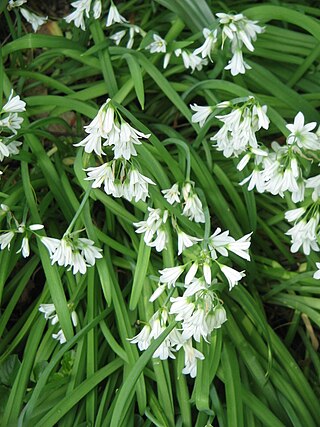
Allium triquetrum is a bulbous flowering plant in the genus Allium native to the Mediterranean basin. It is known in English as three-cornered leek, in Australia as angled onion and in New Zealand as onion weed. Both the English name and the specific epithet triquetrum refer to the three-cornered shape of the flower stalks.

Allium amplectens, the narrowleaf onion, is a species of flowering plant. It is a onion native to the west coast of the United States, in Oregon, Washington State and California, also British Columbia in Canada. It grows in woods and especially in clay and serpentine soils.
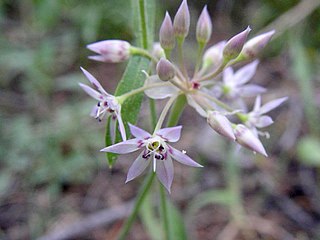
Allium campanulatum is a species of wild onion known by the common name dusky onion or Sierra onion. This is a flowering plant native to the western United States from southeastern Washington and northern Oregon to southern California, and western Nevada. The dusky onion grows in foothills and mountains, especially in dry areas, such as chaparral habitats.

Allium bisceptrum, also known as the twincrest onion or aspen onion, is a high elevation plant native to western United States. It is a perennial that thrives under damp and shady conditions or open meadows in California, Arizona, New Mexico, Nevada, Oregon, Washington, Idaho, and Utah.

Allium fibrillum is a North American species of wild onion known by the common names Blue Mountain onion and Cuddy Mountain onion. It is native to the northwestern United States from eastern Washington and Oregon through Idaho to Montana. It is a perennial herb.

Allium siculum, known as honey garlic, Sicilian honey lily, Sicilian honey garlic, or Mediterranean bells, is a European and Turkish species of plant in the genus Allium. It is native to the regions around the Mediterranean and Black Seas, and grown in other regions as an ornamental and as a culinary herb.

Allium paradoxum, the few-flowered garlic or few-flowered leek, is an Asian species of wild onion in the Amaryllis family. It is native to mountainous regions of Iran, Caucasus, and Turkmenistan and invasive in Europe.

Allium douglasii, the Douglas onion, is a plant species native to northeastern Oregon, eastern Washington, and northern Idaho. It grows in shallow soils at elevations of 400–1,300 m (1,300–4,300 ft).

Allium carinatum, the keeled garlic or witch's garlic, is a bulbous perennial flowering plant in the family Amaryllidaceae. It is widespread across central and southern Europe, with some populations in Asiatic Turkey. It is cultivated in many places as an ornamental and also for its potently aromatic bulbs used as a food flavoring.
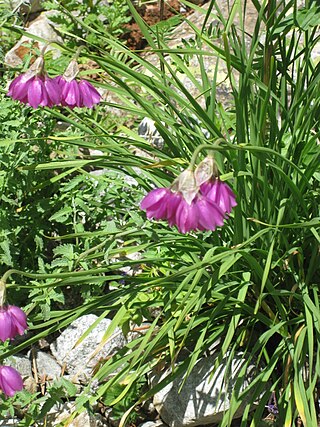
Allium insubricum, the Lombardy garlic, is a species of flowering plant endemic to the Lombardy region in northern Italy. It is named for Insubria, the ancient name for the area around present-day Milan. The species is, however, widely cultivated as an ornamental because of its striking flowers. Its locus classicus is located in Canzo.
Allium tenuiflorum is a Mediterranean species of wild onion found in Algeria, Morocco, Libya, Italy including Sardinia, and the Balkans.

Allium subhirsutum, the hairy garlic, is a plant species widespread around the Mediterranean region from Spain and the Canary Islands to Turkey and Palestine.



















